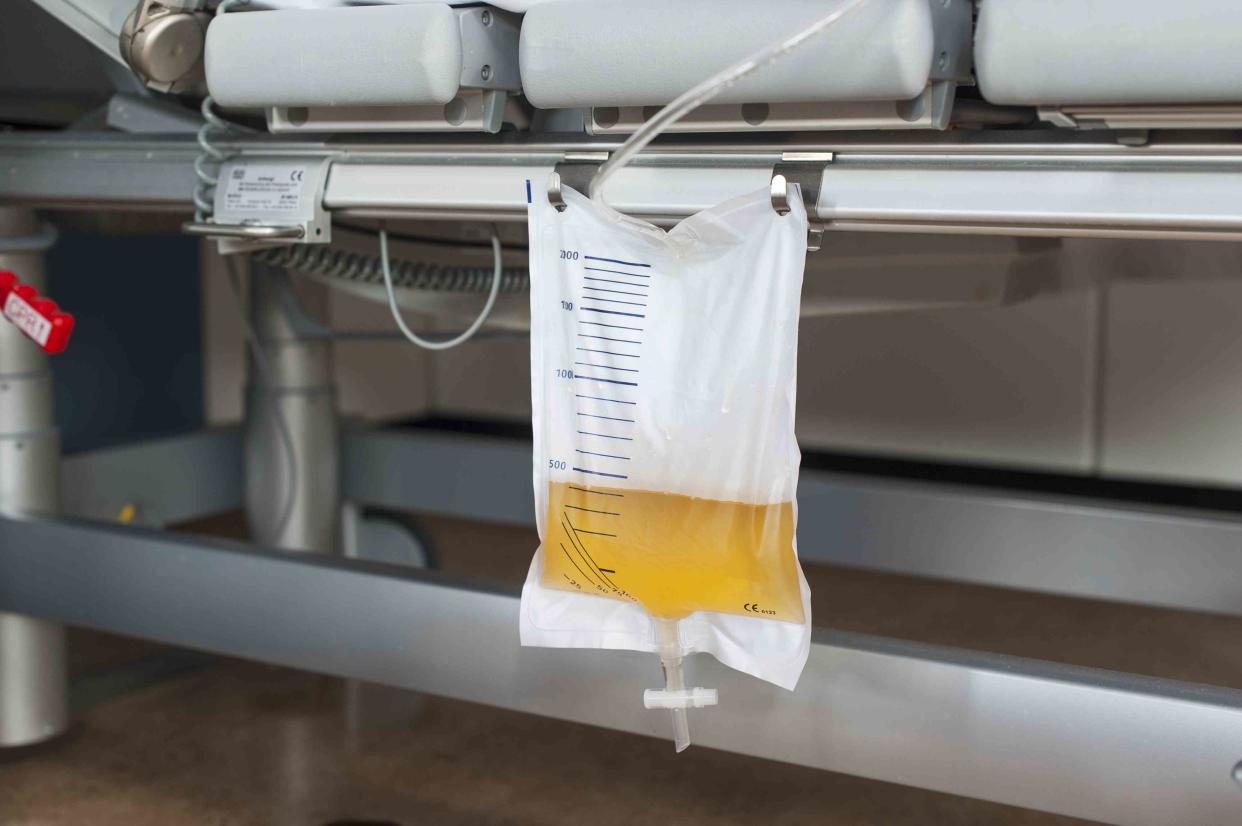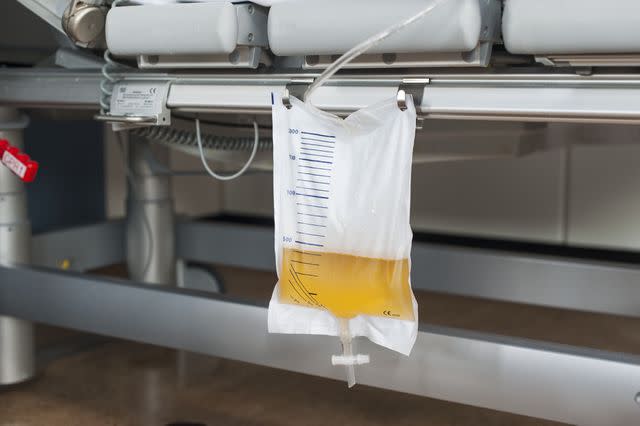Urostomy Overview

ARNO MASSEE / SCIENCE PHOTO LIBRARY / Getty Images
Medically reviewed by Matthew Wosnitzer, MD
A urostomy is a surgical procedure that involves creating an abdominal wall opening to redirect the urine flow from the urinary system to the outside of the body. It is usually performed when the urinary system is damaged or needs to be bypassed due to a disease or condition.
This article will explain what a urostomy is, the purpose of the surgery, what to expect, recovery, and long-term care.

ARNO MASSEE / SCIENCE PHOTO LIBRARY / Getty Images
What Is a Urostomy?
A urostomy is a type of urinary diversion. This surgical procedure establishes a new passageway for urine to leave the body.
Urostomy involves creating an artificial opening in the abdominal wall, called a stoma, to divert urine flow from the bladder to an external pouch or bag. Urostomies are typically performed when the normal urinary system is compromised or nonfunctional, often due to conditions such as:
Spinal cord injuries
Congenital (present from birth) disabilities
During a urostomy, the surgeon disconnects the ureters (tubes that carry urine from the kidneys to the bladder) from the bladder and redirects them to the stoma. The stoma is then brought through the abdominal wall, allowing urine to drain directly into a pouch attached to the outside of the body.
Various Surgical Techniques
Urostomy involves two primary techniques for redirecting urine from the body. These options are incontinent diversion and continent diversion.
Incontinent Diversion
This technique is often called a standard or conventional urostomy. It involves creating a stoma through the abdominal wall to allow urine to drain continuously into an external pouch. The urinary pathway is rerouted, providing a new exit point for urine.
Continent Diversion
A continent diversion urostomy, also known as a continent urinary reservoir, involves creating a storage space for urine inside the body using a section of the intestine.A valve mechanism controls urine flow, and a stoma is created to provide access for emptying the reservoir using a catheter.
Potential Risks
As with any medical procedure, there are potential risks, including:
Complications related to anesthesia administration
Risk of infection at the surgical site
Possibility of bleeding or blood clots
Potential injury to other body parts or organs during the procedure
The formation of scar tissue that may cause a blockage in the small intestine
Changes in bowel function following the surgery
Purpose of a Urostomy
The purpose of a urostomy is to provide an alternative way for urine to leave the body when the normal urinary system is not functioning properly. By creating a stoma, a urostomy allows urine to bypass the affected bladder or urinary tract and be collected in a specialized pouch or bag outside the body.
The external pouches or bags used for collecting urine are typically designed to be discreet, comfortable, and odor-proof. They can be emptied and replaced as needed to manage urine output. Urostomy pouches also typically have adhesive seals that adhere to the skin around the stoma, providing a secure and leak-resistant connection.
How to Prepare
Your healthcare provider will give you information about the surgery, including how it is likely to affect you and the supplies you will need at home.
Here are a few other things to know before your surgery:
Before your operation, your healthcare team will carefully plan the position of your stoma so that your bag will stay in place whether you are sitting, standing, or moving.
The stoma is usually formed on the abdomen, and it may be placed on the right or left of the belly button (navel). Sometimes the position can be tailored to your particular needs; for example, you may prefer a particular side of your body so that it doesn’t interfere with activities such as the sports you play.
You may need to stay in the hospital for up to 10 days.
Tests such as blood tests, X-rays, and imaging scans may be required.
If your surgeon creates a new bladder out of a section of your bowel, you may require a bowel prep (using a laxative medication) the night before.
You will also be advised to avoid eating or drinking anything for a minimum of eight hours before the scheduled surgery. However, confirming the specific fasting requirements with the hospital is essential to ensure a safe surgical experience.
What to Expect on the Day of Surgery
On the day of your operation:
You might be given a special shower gel to cleanse your skin.
You'll change into a hospital gown and wear compression stockings.
Take off all makeup, nail polish, jewelry, and loose items like dentures, glasses, contact lenses, and hearing aids.
You'll be taken on a hospital bed to the operating room.
You will be given an intravenous (IV) catheter on your hand or arm.
Remember to follow all instructions from the hospital staff and ask any questions you may have before the surgery.
Recovery
After a urostomy, patients typically spend around one week in the hospital. Once you're discharged and return home, it's important to take it easy and avoid strenuous physical activities and heavy lifting for approximately one month.
To ensure a smooth recovery, it's crucial to have a discussion with your surgical team to receive personalized instructions tailored to your situation.
Long-Term Care
Caring for a urostomy is essential for maintaining good health and preventing complications. Here are some important long-term care points to keep in mind:
Clean and inspect the stoma and surrounding skin frequently.
Use appropriate urostomy pouching systems that fit well and provide a secure seal to prevent leakage.
Empty the urostomy pouch when it is about one-third full to maintain comfort and prevent overflow.
Change your pouch per your provider's recommendation, such as every one to three days.
Stay hydrated by drinking adequate fluids to maintain normal urine production.
Practice good hygiene by washing your hands thoroughly before and after handling the urostomy pouch.
Avoid harsh chemicals, soaps, or lotions on the skin around the stoma to prevent skin irritation.
If you have a continent urostomy, you'll need to use a small tube called a catheter to empty the pouch multiple times daily. As time passes, you can do this less frequently as the pouch becomes larger. Having a urostomy does not decrease life expectancy.
Summary
Urostomy is a surgical procedure that involves creating an opening in the abdomen to redirect urine flow after the bladder has been removed or bypassed. By providing an alternative urinary pathway, urostomy allows many people to regain control over their bodily functions, resume their daily activities, and potentially enjoy a better quality of life.
If you have any questions or concerns about urostomy, it's essential to discuss them with your healthcare provider, who can provide guidance, and support and address any specific concerns you may have.

